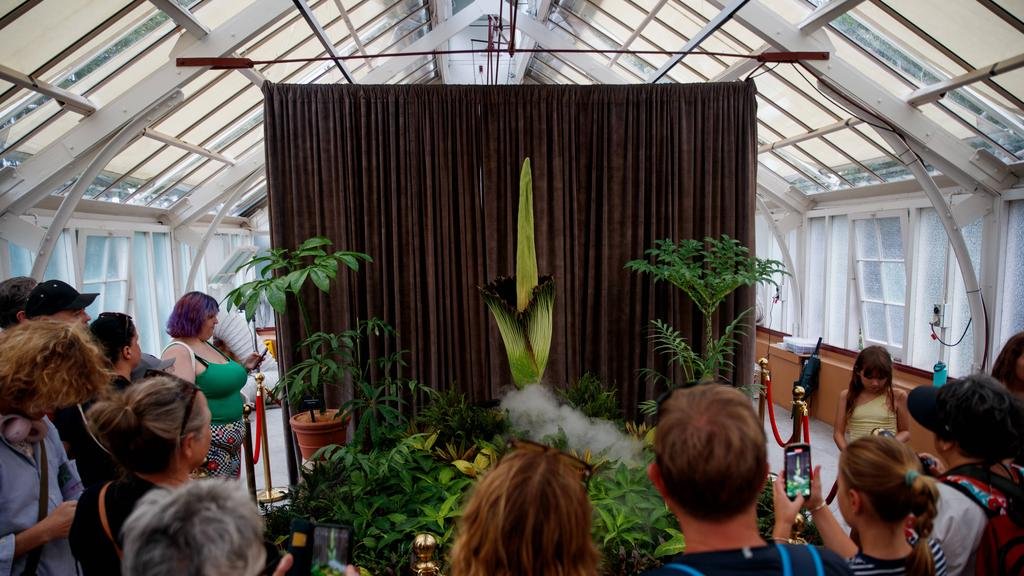Sydney’s Royal Botanic Gardens has been buzzing with excitement as visitors from across the country flock to witness the rare and remarkable blooming of Putricia, the corpse flower, for the first time in 15 years. Officially known as Amorphophallus titanum, the towering plant has long been known for its highly distinctive, foul odor and has become a highly anticipated botanical spectacle for those lucky enough to witness it.
This ultra-stinky flower, also called the corpse flower due to its infamous smell, has finally uncurled its deep crimson petals, unveiling a powerful odor described by many as a combination of rotting flesh, hot cat food, and sweaty socks. For the first time in over a decade, the pungent smell filled the air of the Botanic Gardens, causing both awe and repulsion among visitors. The bloom, which only occurs once every several years, marks a fleeting event in the flower’s lifecycle and a rare moment for botanists and flower enthusiasts to celebrate.
The smell, however, serves an important biological purpose. The flower is designed to mimic the scent of decaying meat in order to attract pollinators such as flies, who are drawn to lay their eggs in rotting flesh. As these insects transfer pollen, the plant is able to reproduce and ensure the continuation of its species. According to Professor Brett Summerell, chief scientist at the Botanic Gardens of Sydney, the specific compounds responsible for the unpleasant smell are putrescine and sulfur-based substances, which emit the characteristic stench.
“It’s amazing if you think about it,” Professor Summerell commented. “The flower has evolved to reproduce using a scent that draws in insects that typically lay their eggs in decaying organic material.”
The blooming of the corpse flower is a delicate process, one that requires the right conditions to thrive. Native to the rainforests of Sumatra, Indonesia, the corpse flower prefers high humidity, making it a challenge for the Botanic Gardens to successfully host the flower. As the plant was relocated from its original glasshouse environment, scientists had to take extra steps to recreate the tropical conditions needed for the flower to bloom. This included using a misting machine that pumps water vapor to maintain the humidity levels, ensuring the flower’s health and maximizing the chances of its bloom.
The misting system has also provided a bit of extra entertainment for the crowds, adding a humorous touch to the spectacle. Visitors have found delight in watching the machine puff water vapor around the plant while also jokingly referring to the machine as a “flower guardian.”
Since the bloom began, more than 16,000 visitors have passed through the gates of the Botanic Gardens in hopes of seeing the rare flower firsthand. For those unable to visit in person, the Botanic Gardens set up a livestream that has garnered more than 500,000 views, allowing people from around the world to virtually witness the flower’s progress. The online community of “Putricians,” as the livestream followers call themselves, have been watching eagerly as the flower slowly opens, offering words of encouragement and excitement from afar.
Those who have managed to visit in person can be seen lining up to take selfies in front of the flower, many leaning in to get a closer look at the giant plant. Others have even waved handmade signs at the camera, proudly showing their support for the flower and its grand unveiling. Botanists have also become part of the spectacle, checking on the plant’s progress and occasionally bowing to the flower in reverence. Their frequent appearances have added to the drama of the event, with some even caressing the flower’s base as they ensure its continued development.
The bloom is expected to last for just 24 hours, with the flower beginning to wilt shortly after the full reveal. The brief window for the flower’s bloom is due to the immense amount of energy required to produce the odor and keep the flower upright during its peak. Once the flower has completed its reproductive function, the energy spent on the bloom causes it to close and begin the wilting process.
As visitors marvel at the flower’s strange beauty and powerful smell, the bloom stands as a testament to the wonders of nature and the intricate evolutionary processes that drive such phenomena. Though the flower’s scent may not be to everyone’s liking, it remains a remarkable and rare event, attracting crowds who appreciate the spectacle of nature in all its raw, unrefined glory.
For many, this rare blooming is a once-in-a-lifetime experience. The crowds that gathered to witness Putricia’s bloom were treated to more than just a visual wonder; they were able to immerse themselves in the sensory experience of an odor so unique that it is often described as both fascinating and revolting in equal measure.
The excitement surrounding Putricia’s bloom highlights the growing interest in botanical marvels and the ways in which people connect to the natural world. Whether it’s through the thrill of seeing something rare, experiencing a sensory overload, or participating in an online community of flower enthusiasts, the bloom of the corpse flower has become an event that draws people together to witness nature at its most captivating, and perhaps, its most extreme.



